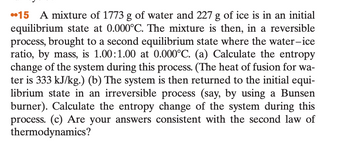
College Physics
11th Edition
ISBN: 9781305952300
Author: Raymond A. Serway, Chris Vuille
Publisher: Cengage Learning
expand_more
expand_more
format_list_bulleted
Question

Transcribed Image Text:15 A mixture of 1773 g of water and 227 g of ice is in an initial
equilibrium state at 0.000°C. The mixture is then, in a reversible
process, brought to a second equilibrium state where the water-ice
ratio, by mass, is 1.00:1.00 at 0.000°C. (a) Calculate the entropy
change of the system during this process. (The heat of fusion for wa-
ter is 333 kJ/kg.) (b) The system is then returned to the initial equi-
librium state in an irreversible process (say, by using a Bunsen
burner). Calculate the entropy change of the system during this
process. (c) Are your answers consistent with the second law of
thermodynamics?
Expert Solution
This question has been solved!
Explore an expertly crafted, step-by-step solution for a thorough understanding of key concepts.
This is a popular solution
Trending nowThis is a popular solution!
Step by stepSolved in 2 steps with 2 images

Knowledge Booster
Learn more about
Need a deep-dive on the concept behind this application? Look no further. Learn more about this topic, physics and related others by exploring similar questions and additional content below.Similar questions
- A heat engine operates under the following thermodynamic cycle:A→B: isobaric expansion(P=const.)B→C: isochoric cooling(V=const.)C→A: isothermal compression(T=const.)The engine is operated by nmoles of oxygen, a diatomicgas which behaves like an ideal gas without any appreciable vibrational kinetic energy.The thermodynamic cycle described by the gas is entirely defined by pressures PAand PC, and volume VA. Assume that PC=PA/2and give all your answers in terms of n, R, PAand VA. b)Sketch the cycle on a P-Vdiagram and determine all the unknown pressures, volumes and temperatures. c)Determine the efficiency of this engine, defined by e =Wnet/Qin.Wnetis the net work done by the gas over a full cycle and Qinis the total heat that flows into the gas.Be careful, Qindoes not include the heat released by the gas.arrow_forwardWhen 1.60 ✕ 105 J of heat transfer occurs into a meat pie initially at 20.0°C, its entropy increases by 465 J/K. What is its final temperature (in degrees)? _________ °Carrow_forward53. What is the decrease in entropy of 25.0 g of water that condenses on a bathroom mirror at a temperature of 35.0° C, assuming no change in temperature and given the latent heat of vaporization to be 2450 kJ/kg?arrow_forward
- 9-59E An ideal dual cycle has a compression ratio of 15 and a cutoff ratio of 1.4. The pressure ratio during constant- volume heat addition process is 1.1. The state of the air at the beginning of the compression is P =14.2 psia and T, = 75°F. Calculate the cycle's net specific work, specific heat addition, and thermal efficiency. Use constant specific heats at room temperature. %3Darrow_forwardFind the change in entropy that results when a 3.2-kg block of ice melts slowly (reversibly) at 1 °C. Assume that Latent frequency is 3.35 x 10^5 J/Kg.arrow_forwardThe Sun radiates energy at the rate of 3.80 ✕ 1026 W from its 5500°C surface into dark empty space (a negligible fraction radiates onto Earth and the other planets). The effective temperature of deep space is −270°C. (Due to the sensitive nature of the calculations, use T(K) = T(°C) + 273.15. ) (a) What is the increase in entropy (in J/K) in one day due to this heat transfer?arrow_forward
- 29) Calculate the change in entropy (AS) for the process of freezing 2 kg of liquid methane at 182°C to solid methane at -182°C. Heat of melting/freezing for methane is 59 kJ/kg. A: 0.94 kJ/K B: -0.94 kJ/K C: 1.3 kJ/K D: -6.0 kJ/K E: - 1.3 kJ/K Considering justarrow_forwardA block made of cobalt with a mass of 0.80 kg is heated to 850°C, then dropped into 5.00 kg of water at 10°C. What is the total change in entropy (in J/K) of the block-water system, assuming no energy is lost by heat from this system to the surroundings? The specific heat of cobalt is 420 J/(kg · K), and the specific heat of water is 4,186 J/(kg · K). (Hint: note that dQ = mcdT.)arrow_forward4) Please help with the following question (second picture)!arrow_forward
arrow_back_ios
arrow_forward_ios
Recommended textbooks for you
 College PhysicsPhysicsISBN:9781305952300Author:Raymond A. Serway, Chris VuillePublisher:Cengage Learning
College PhysicsPhysicsISBN:9781305952300Author:Raymond A. Serway, Chris VuillePublisher:Cengage Learning University Physics (14th Edition)PhysicsISBN:9780133969290Author:Hugh D. Young, Roger A. FreedmanPublisher:PEARSON
University Physics (14th Edition)PhysicsISBN:9780133969290Author:Hugh D. Young, Roger A. FreedmanPublisher:PEARSON Introduction To Quantum MechanicsPhysicsISBN:9781107189638Author:Griffiths, David J., Schroeter, Darrell F.Publisher:Cambridge University Press
Introduction To Quantum MechanicsPhysicsISBN:9781107189638Author:Griffiths, David J., Schroeter, Darrell F.Publisher:Cambridge University Press Physics for Scientists and EngineersPhysicsISBN:9781337553278Author:Raymond A. Serway, John W. JewettPublisher:Cengage Learning
Physics for Scientists and EngineersPhysicsISBN:9781337553278Author:Raymond A. Serway, John W. JewettPublisher:Cengage Learning Lecture- Tutorials for Introductory AstronomyPhysicsISBN:9780321820464Author:Edward E. Prather, Tim P. Slater, Jeff P. Adams, Gina BrissendenPublisher:Addison-Wesley
Lecture- Tutorials for Introductory AstronomyPhysicsISBN:9780321820464Author:Edward E. Prather, Tim P. Slater, Jeff P. Adams, Gina BrissendenPublisher:Addison-Wesley College Physics: A Strategic Approach (4th Editio...PhysicsISBN:9780134609034Author:Randall D. Knight (Professor Emeritus), Brian Jones, Stuart FieldPublisher:PEARSON
College Physics: A Strategic Approach (4th Editio...PhysicsISBN:9780134609034Author:Randall D. Knight (Professor Emeritus), Brian Jones, Stuart FieldPublisher:PEARSON

College Physics
Physics
ISBN:9781305952300
Author:Raymond A. Serway, Chris Vuille
Publisher:Cengage Learning

University Physics (14th Edition)
Physics
ISBN:9780133969290
Author:Hugh D. Young, Roger A. Freedman
Publisher:PEARSON

Introduction To Quantum Mechanics
Physics
ISBN:9781107189638
Author:Griffiths, David J., Schroeter, Darrell F.
Publisher:Cambridge University Press

Physics for Scientists and Engineers
Physics
ISBN:9781337553278
Author:Raymond A. Serway, John W. Jewett
Publisher:Cengage Learning

Lecture- Tutorials for Introductory Astronomy
Physics
ISBN:9780321820464
Author:Edward E. Prather, Tim P. Slater, Jeff P. Adams, Gina Brissenden
Publisher:Addison-Wesley

College Physics: A Strategic Approach (4th Editio...
Physics
ISBN:9780134609034
Author:Randall D. Knight (Professor Emeritus), Brian Jones, Stuart Field
Publisher:PEARSON